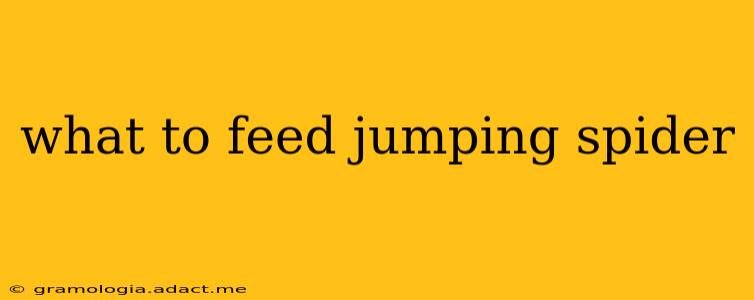Jumping spiders are fascinating creatures, known for their vibrant colors, exceptional hunting skills, and surprisingly adorable personalities. Owning a jumping spider can be a rewarding experience, but providing the right diet is crucial for their health and longevity. This guide will cover everything you need to know about feeding your jumping spider, addressing common questions and concerns.
What do jumping spiders eat?
Jumping spiders are carnivores, meaning their diet consists entirely of live prey. They are ambush predators, patiently waiting to pounce on unsuspecting insects. In the wild, their diet varies depending on their size and the availability of prey, but generally includes:
- Flies: These are a staple food source for most jumping spiders, offering a good balance of nutrients. Fruit flies ( Drosophila melanogaster ) are particularly popular due to their small size and ease of breeding.
- Small Crickets: These are a good option for larger jumping spiders, but should be offered in moderation and appropriately sized to avoid injury to the spider.
- Mealworms: While nutritious, mealworms should be offered sparingly as they are higher in fat and chitin than other options. Furthermore, they should be gut-loaded prior to feeding to ensure maximum nutritional value.
- Other small insects: This can include aphids, springtails, and other small invertebrates, depending on the size of your spider and availability.
How often should I feed my jumping spider?
Feeding frequency depends on the age and size of your spider. Young, growing spiders need to be fed more frequently than adults. A good rule of thumb is:
- Juveniles: Daily or every other day.
- Adults: Every 2-3 days, or even less frequently if they are not consuming all the prey offered.
Always remove uneaten prey after a few hours to prevent it from becoming a source of contamination in the enclosure.
What size prey should I feed my jumping spider?
The prey should be no larger than the spider's abdomen. Offering excessively large prey can stress or injure your spider. It's better to err on the side of caution and provide smaller, more frequent meals.
Can I feed my jumping spider dead insects?
No, jumping spiders will not eat dead insects. They require live prey to trigger their hunting instincts.
What about commercially available spider food?
While some commercially available foods exist for spiders, these are often not ideal and may lack essential nutrients compared to live prey. It’s always best to stick with a diet of live insects.
My jumping spider refuses to eat. What should I do?
There could be several reasons for this:
- Too much food: If you’ve been overfeeding, your spider may simply be full.
- Stress: A change in environment or handling can cause stress, leading to a lack of appetite.
- Molting: Jumping spiders will stop eating before and during molting.
- Illness or injury: If your spider hasn't eaten for an extended period, consider consulting a veterinarian specializing in exotic pets.
How do I store live food for my jumping spider?
You can keep live food in a separate container with appropriate ventilation and moisture. Fruit flies are best kept in a culture to ensure a consistent supply. Crickets can be kept in a cricket keeper with suitable substrate.
Can I breed my own food for my jumping spider?
Breeding fruit flies is relatively easy and a great way to have a constant supply of food for your smaller jumping spiders. There are numerous guides and resources available online for setting up a fruit fly culture.
By following these guidelines, you can ensure your jumping spider receives the proper nutrition, leading to a healthy and happy life. Remember to always observe your spider's behavior and adjust feeding accordingly. If you have any concerns about your spider's health, consult with a qualified veterinarian or experienced spider keeper.
